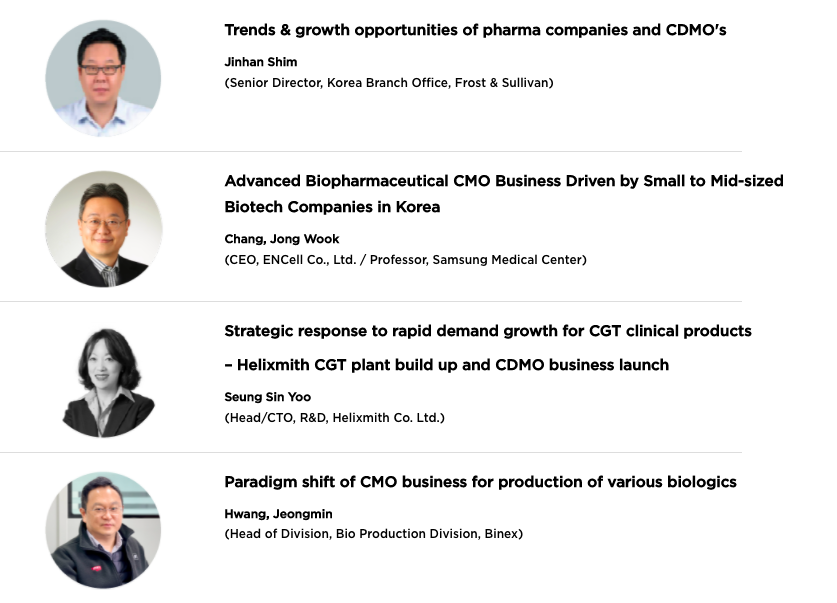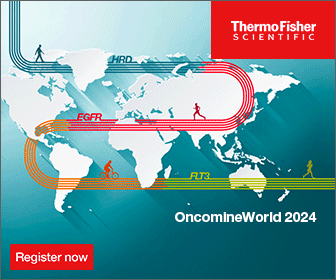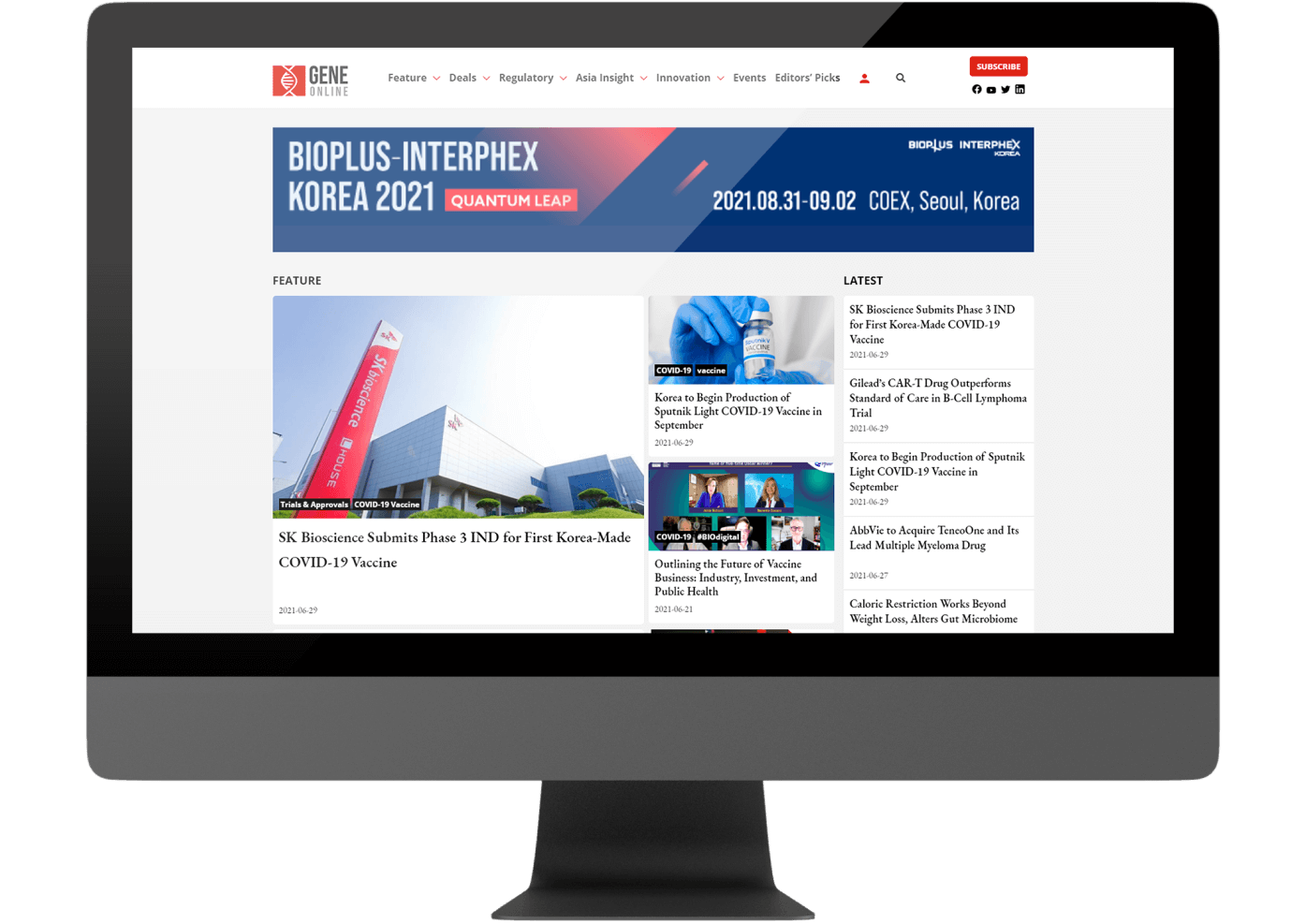Bioplus Interphex 2021: CDMOs- The Manufacturing Hub for the Next Generation of Therapeutics
The Covid-19 pandemic ushered in an unprecedented era of collaboration between startups and CDMOs to bring mRNA and protein vaccines to the market at breakneck speed. At the Bioplus Interphex 2021, a global bio-pharmaceutical convention, industry leaders exchanged notes on how CDMOs can facilitate the next generation of therapeutics. In a session titled “Bio CMOs Big Leap- Pharmaceutical Optimization Production Strategy”, moderated by Young Wan Lee, Senior staff writer, Business & Technology desk, The Chosunilbo, panellists shared their views on emerging trends and the future of CDMOs. The panel consisted of:
- Jinhan Shim, Senior Director, Korea Branch Office, Frost & Sullivan
- Jong Wook Chang, CEO, ENCell Co., Ltd. / Professor, Samsung Medical Center
- Seung Sin Yoo, Head/CTO, R&D, Helixmith Co. Ltd.
- Jeongmin Hwang, Head of Division, Bio Production Division, Binex

Trends & Growth Opportunities for Pharmas and CDMOs
Shim reviewed the global landscape of biopharma and CDMOs, in the wake of the Covid-19 pandemic which has generated major momentum in biotech investments. While small molecule drugs continue to dominate the market, biologics are fast catching up, with more than 5000 products in various stages of clinical trials in 2020. Venture capital investments in small biotech companies for cell and gene therapies has grown since 2020 with significant opportunities for startups developing products in key areas, such as systemic infections, oncology, CNS disorders.
Accoding to Shim, CROs help in early stage research and discovery, while CDMOs are important for primary manufacturing, supply and large scale logistics. CDMOs need to provide diverse technology platforms, capacity building, agile and flexible manufacturing and enter into strategic partnerships to be successful. Early collaborations, mostly during the preclinical stages, are crucial to ensure growth. Shim noted that Merck, Genentech, ConcertAI are some of the CDMOs to watch out for in the cancer gene therapy space, while Rakuten Medical and Curevac are doing well in precision oncology. The top CDMOs like ThermoFisher are diversifying their portfolios and entering long-term partnerships with small biotechs with innovative products.
Related Article: Samsung Biologics Inks CDMO Deal with Enzolytics on HIV and COVID-19 Antibodies
Advanced Biopharmaceutical CMO Business Driven by Small to Mid-sized Biotech Companies in Korea
Dr. Chang discussed the current status of advanced biopharma, various classes of biopharmaceuticals, forecasts for CDMOs, and challenges in cell and gene therapy.
Dr.Chang reviewed the growth of CDMO markets and forecasts till 2026. With a revenue of $11.3 billion in 2020, the global CDMO market is expected to grow to $20.31 billion by 2026, with a consistent 10% growth p.a.. The CDMO market for clinical trials is expected to grow by 26% p.a. and those in commercialization technologies are looking at 32% p.a. growth.
Gene therapy and Cell therapy markets are expected to grow at 27% p.a. and 36% respectively. Regenerative medicine has garnered significant investments with over $14 billion raised in 2021.
More than 1100 companies worldwide are developing gene and cell therapy products with over 1000 industry-led clinical trials and over 100 products from South Korea and Taiwan. With South Korea and Taiwan leading the Asia market in cell and gene therapies, CDMOs are very attractive for smaller companies to help them bring their products to the market.
Strategic Response to Rapidly Growing Demand for CGT Clinical Products
Yoo described the evolution of Cell and Gene therapies (CGT) since the first CAR-T cell therapy, Kymriah from Novartis. In the aftermath of the pandemic, CGTs have exploded and CDMOs need a strategic response to rapid demand and growth.
With multiple options available for therapeutic agents- DNA/RNA/Protein, vectors like AAVs, retroviruses, liposomes and delivery methods- in vivo, ex vivo, CGT is emerging as a promising class of therapeutics. Comparing the potential of CGTs to MAbs, Yoo noted that the CGT market is well differentiated with innovative products from small biotech for rare diseases and oncology. Clinical trials are different and riskier and there are often issues with scale-up and consistent quality. Currently, there are over 7000 molecules in the pipeline for CGTs- CAT-Ts, viral vaccines, gene editing for rare diseases etc. The global CGT market is expected to grow by 40% in 2026 and the associated CDMO space has been growing at 30% p.a.
Noting the parameters of a successful CDMO, Yoo mentioned that expertise with diverse and complex technologies, ensuring high quality, speed and suitable infrastructure make ideal candidates. Since CGT products are more complex than pharmaceutical molecules, CGT production capacity is limited and needs to be expanded based on the number of products in different phases of clinical trials. Process and analytical technologies need attention and that is where CDMOs can be successful.
Paradigm Shift of CMO Business for Biologic Production
Hwang introduced single-use production systems to make biologics. Discussing the benefits of single use systems vis-a-vis the traditional stainless steel reactors, Hwang mentioned faster turnaround times, decreased cross-contamination, ease of redesign and modifications, less capital investment and ability to produce a diverse range of products.
With continual improvements in cell line development, culture media, methods of cell culture, productivity and product refinement have been maximized for biopharmaceutical manufacture. Perfusion culture allows for smaller volumes of cell culture while maintaining high yields. Hence upstream technologies have enabled greater consistency in product manufacture.
Hwang noted that disposable/single use plastics are being designed to replace the most crucial and vulnerable parts of the production machinery such as tubings, media bags, connectors, filters, cartridges etc. Binex has hybrid mammalian and microbial production lines with a combination of stainless steel equipment and single use parts which allows for increased flexibility, ensures sterilization and quality, redesigning and scaling up/down which can manufacture mRNA vaccines, subunit vaccines, cell and gene therapy products at the same sites.










